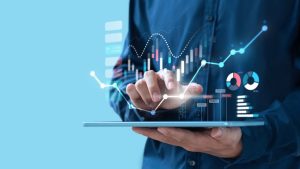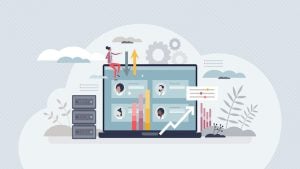What Are The Different Types of HR Analytics?
 Publié le 22 November 2023
Publié le 22 November 2023
Correctly use data to improve your business and recruit the best people by asking what are the different types of HR analytics.
It’s a truth widely acknowledged that data-driven decision-making is a key ingredient for any business to grow and succeed. But how can HR leaders ensure their strategies are backed by data? Among the answers to this question, one solution stands at the front of the line: HR analytics.
Sometimes referred to as people analytics, HR analytics is a tool by which organizations can get keen insights into their HR operations. With this information, they can see what’s working well and which areas are in need of improvement.
What are the different types of HR analytics? There are actually four different types, which we’ll get to a little later. But first, let’s discuss the basics in a bit more detail.
What is HR Analytics?
Just in case you’re not familiar with the term, HR analytics is the collection, processing, and interpretation of data about a company’s employees and working practices. By using data sharing services and analytics tools, HR personnel can make better decisions around things like training, development, and employee engagement. This aids in improving employee performance and aligning HR strategies with company goals.
Free to use image sourced from Unsplash
What are the different types of HR analytics?
HR analytics can be classified into four distinct categories, each serving a specific purpose in deciphering workforce dynamics.
1. Descriptive Analytics
First up we have descriptive analytics, which focuses on scrutinizing historical data and establishing a clearer idea of how a business has evolved. By analyzing important HR metrics through descriptive analytics, you can easily identify various trends and patterns, such as time and attendance or workforce demographics.
It is then possible to discern areas of strength and weakness. Perhaps staff turnover was high in the previous year, or absenteeism has decreased in the last six months. Altogether, this draws a detailed picture of your company’s workforce history date.
2. Diagnostic Analytics
Next up we have diagnostic analytics. This type of HR analytic goes further than descriptive analytics and asks why these patterns are occurring. Taking historical data and using tools like data visualization, it is possible to start unearthing what the root cause of any trend might be.
Let’s take the example of high employee absenteeism. Descriptive analytics will throw up the flag that this is occurring, and then diagnostic analytics will investigate what factors have contributed to it. Perhaps it’s poor job satisfaction? Or, are people overworked and struggling? Diagnostic analytics helps you to dig out the root cause of any organizational behavior.
Free to use image sourced from Unsplash
3. Predictive Analytics
Whereas descriptive analytics is concerned with the past, predictive analytics looks to the future — albeit still with the use of that trusty historical data. With the knowledge and analysis of previous trends, predictive analytics gives you a good idea of what might lie ahead and helps to prevent issues before they arise.
One area where this can be particularly useful is employee turnover. According to the latest federal reports, a record 50.5 million people quit their jobs in the US last year, which has naturally had a big effect on employers and the job market. This impact can be mitigated when you can predict and prepare for a potential wave of employees handing in their notice.
When you can analyze job satisfaction metrics, market trends, and changes in engagement levels, you are then able to foresee potential increases in employee turnover and initiate retention strategies. After all, it’s better to be proactive than reactive.
4. Prescriptive Analytics
Here we’ve reached the cutting-edge summit of HR analytics, the absolute pinnacle of HR data insight. These heady heights are attained with advanced tools like machine learning, AI, and algorithms. To make the best use of these tools, it’s also wise to have data clean room solutions in place to ensure all the data you’re using is accurate and reliable.
By using these tools you’ll be able to get solutions even amidst the most complex workplace challenges. Say your company is struggling with its diversity and inclusion efforts. You can use analytics to mine data from performance reviews and demographics, which will then deliver potential solutions.
It may suggest the need for changes in recruitment practices or mentorship initiatives. The HR department can then make decisions confidently, knowing they are backed by good data.
Free to use image sourced from Unsplash
Why do companies need people analytics?
People analytics provides an abundance of benefits to businesses. Read on to learn more.
Improved talent acquisition
Attracting the right talent is a top priority for any HR department. Analytics can assist from the initial identification of potential applicants to choosing the right candidate for the role. It can help you to check that candidates have the requisite skills and assess how well they’ll fit in with your company’s culture and ethos.
HR professionals can then spend less time trawling through unsuitable candidates and more time on the higher-level aspect of recruitment. This can significantly drive down the cost of hiring, which currently stands at around $4,700.
Managing employee productivity and performance
Workforce analytics is like a performance booster for management. With it, you can measure productivity and performance and find solutions to support employees in reaching their goals. First, you locate the productivity problems, then you work on a fix.
Say an IT professional is unable to deal with as many remote employee tickets as expected. Analytics can help to determine that it’s taking too long to connect to each remote desktop one at a time, whereas implementing a remote desktop connection manager will expedite the process significantly. This is just one way that zeroing in on a productivity problem can quickly lead to a solution.
Better workforce planning
Following “The Great Resignation” the recruitment market continues to be a complicated place. This makes it even more important that businesses are able to accurately predict future staffing requirements so that they’re not caught short-handed. Alongside a business risk assessment matrix, predictive analytics is invaluable in this regard.
You can take the historical trend analysis we looked at earlier and create a data-backed image of what talent you need to hire in order to meet future demands. As a result, you can keep ahead of the recruitment game and prevent understaffing issues from hurting team satisfaction.
Free to use image sourced from Unsplash
Identifying skill gaps
Even if you think you’ve sussed everything you need to know about upskilling, skill gaps can still catch us off guard. However, they also present opportunities for real advancement when they’re addressed correctly using HR analytics.
Analytics can pinpoint exactly where the skills gaps are so you can introduce targeted training and development programs. This should be an ongoing process as workforce and business demands change, so it becomes a working environment of continual learning.
Preventing workplace misconduct
Problems like harassment, discrimination, and bias can happen in any company, directed at both employees and customers. To make sure it never goes unreported, use data-driven employee and customer surveys to open up communication and take action when you get feedback.
Tools like call tracking for small business use can even record conversations so that you can keep an eye out for any misconduct. This goes some way to creating the safe and inclusive work environment that everyone deserves.
The Importance of HR Analytics
Data, data, data; it’s worth its weight in gold. Everywhere, businesses are looking to optimize their data to make it safe, accessible and usable. Maybe you’re new to the data game, or perhaps you’re an experienced pro who has already implemented a data warehouse migration to cloud.
Regardless, HR analytics should be your next data-focused move. Here’s why:
- HR strategy and data-driven decisions: It’s far better to make decisions that are supported by concrete data, than choices that are based on guesswork and assumptions. Your HR strategies are therefore more likely to succeed.
- Equitable compensation and benefits: A fair and inclusive work environment is the ideal to which we should all be striving. Analytics will help you to ensure that all compensation and benefits are fairly allocated and disparities are addressed.
- Employee training and development: HR analytics can also play a crucial role in enhancing employee training and development programs. By analyzing data on employee performance and identifying skill gaps, you can tailor training initiatives to meet the specific needs of your workforce, ultimately fostering a more skilled and engaged team.
- Reduce employee turnover: Many HR departments are acutely aware of why employee turnover is so expensive and have struggled to stem the flow. Thankfully, analytics can help you to establish the exact reasons for high staff turnover, so you can develop your retention strategy accordingly.
Free to use image sourced from Unsplash
What is the future of HR analytics?
The great news is that HR analytics is constantly updating and becoming ever more advanced. One of the most exciting developments is the arrival of AI on the recruitment scene, with 81% of HR leaders having already explored or adopted AI solutions to improve efficiency.
This technology can scour through a vast pool of candidates in a fraction of the time an employee would be able to do it. As such, the hiring process is much quicker. Plus, AI can uncover qualities that might have otherwise been overlooked, so you have a better chance of hiring the right person.
Another thing to be on the lookout for is personalization. No more standardized employee development plans. Instead, they’ll be personally tailored towards each employee’s strengths and opportunities for improvement.
All in all, there are exciting times ahead for HR analytics.
Elevate your HR strategy
If you’re not using data analytics in your HR operations yet, now is the time to start. When you take valuable data and analyze it effectively, you will discover unparalleled insights into your workforce. This information will drive decision-making and allow for the development of more successful strategies. HR analytics has become an indispensable part of many companies’ success, so don’t miss out.







